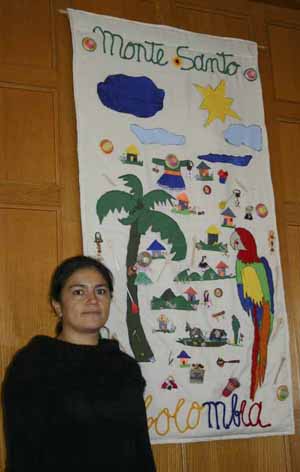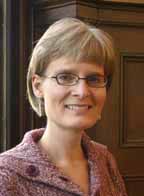Canadian Mennonite
Volume 11, No. 01
January 8, 2007

On being brothers and sisters
 |
Sandra Rincón preached the following sermon at First Mennonite Church, Kitchener, Ont., on World Fellowship Sunday 2006. (In Spanish, the day is known as Domingo de la Fraternidad Mundial or World Brotherhood/Sisterhood Sunday. The Spanish word is gender neutral; hence the focus on what it means to be brothers and sisters. Her text was Genesis 33:1-8.) Rincon is a member of Comunidad del Monte Santo in Madrid, Colombia, which has had a reciprocal relationship with First Mennonite for the past three years; the congregations have exchanged banners (see front cover), cards, children’s drawings, photos and gifts, as well as a vibrant prayer ministry for each other.
It was difficult to write this meditation. Seeing the relationship between brothers and sisters at a broad level makes me think about the suffering of so many persons in the world. So many human beings like us who do not have bread, who do not have peace, who do not have life. So many human beings who view the other with hatred, with resentment, with evil, and who want to kill or destroy others simply because they think or feel differently, or out of jealousy or envy.
The Bible is not free of such examples: Cain and Abel, Joseph and his brothers, Jacob and Esau. This constant struggle for power, control and riches is slowly destroying us, is distancing us from the will of God, where love, forgiveness and community are the fundamental principles for a better common life.
The South perceives the North as a paradise, the North sees the South as a dark place. The South is poor because of the constant robbery by the countries of the North. The inhabitants of the North are not even aware that their privileges come from the suffering and the lives of millions of human beings who are exploited, humiliated and subjected to violence.
Among them are the indigenous peoples of the North and the South who were, or are, being exterminated—all because of the lack of conscience as development, civilization and the future advance. A lack of conscience of which our churches—including the Mennonite Church—are a part. From their big armchairs, the men and women of the world invented this division, this gulf that seems to have no solution, because we do not matter to one another.
Brothers and sisters, sons and daughters of the Spirit of Life, we are destroying one another. I do not understand why. Those of us who call ourselves Christians are not living the message of reconciliation of Jesus in the building of our church, in his challenge to our comfort.
On occasion, we are the ones who most participate in these divisions between brothers and sisters because we do not understand, we do not discern the Word of God, a father who wants a true place for each of us, a place in this world that was made for us, for all. Mistrust, fear of the other and self-protection are feelings that do not permit us to draw near to one another. They make us relate with our hearts completely armed, making integration between the sons and daughters of God more difficult.
How many more years, how many more deaths, will we need before we see each other as brothers and sisters? When will this all stop? I don’t know.
But we as a church continue to have the great task of opening our arms to accept the other as he or she is. We have the challenge of knowing God beyond the four walls of our houses, workplaces and churches. We have the challenge of lifting our voice as prophets to denounce injustice, to clamour for truth, and to permit the reconciling love of God to flow through our veins—so that one day the North may ask forgiveness of the South for so much destruction, and that the South may firmly determine that it does not want to continue the wave of death that surrounds it. So that with humility we may re-encounter one another, and set out running to embrace one another, to cry, to be broken and to be transformed by the love of God, as happened with Jacob and Esau.
It is not an easy path, nor a short one. We, as sister churches, have set out on a path, trying to build a bridge across that gulf that separates us. We do not know with certainty who we are, we do not know how to treat one another without mistrust. We only know that God is with us and will be on that path.
I, as a member of Comunidad del Monte Santo congregation in Madrid, Colombia, bring longings, wishes, concerns, greetings, to share with you, as Jacob brought all his belongings to share with Esau.
I want to tell you that the situation in Colombia is difficult for the poor, that there is a great concern about the re-election of Uribe and his policy of “democratic security,” which opens the doors ever wider to poverty, violence and death. As a church, we have to discern and decide on our role in the municipality and in the region. We have to look for ways to support ourselves—to obtain the bread, the health services, the housing—to survive. At the same time, we continue to trust and believe in God, which is not always easy.
With pain we see the effects of evil, hatred and violence in our surroundings, which are not only Colombian products, but also Canadian and U.S. products. We hear the stories of our neighbours who have been displaced and who can only serve one meal to their children. We hear the life stories of persons who come to our church seeking acceptance, love and restoration. And we feel that our call is with these persons.
The call to love the other begins with our own lives and flows out in the life of others. Our church has changed. The older people remember a country without violence, the adults can no longer perceive our country without so many problems, and the children are growing up in a place with few opportunities.
We do not know if we are prepared for the new challenges ahead, but we trust that God will guide and strengthen us. As we seek these answers as Christians, we support one another and we seek the company of others, because we want to form “community.”
In this space where we meet you, where we have chosen you and where we are telling you that we want you to come to know us, we want you to see us as your brothers and sisters in Christ. We want to share the same table with you. We want you to hear about how our life is going, about our hopes and our suffering. We want you to be our brothers and sisters, as Jesus was the brother of every one of his disciples, friends, family, as Jesus was the brother of his enemies.
This is a challenge for you and for us, we know. The church in Madrid has taken it on and has given it a special place in our vision as community. We hope that it is also so for you, our sister church in the North.
‘Refreshing winds’ of worship
Canadian Mennonite concludes its three-part series on worship in preparation for the Canadian Mennonite University (CMU) Refreshing Winds conference later this month in Winnipeg, with reflections on worship issues close to the heart of three CMU staff members.
.jpg) |
Binding congregants together
What does it mean to worship as a community—not just as a collection of individuals? How can worship help people truly find and meet God? How can it bring people together? And how can Christians achieve some sense of understanding about the role of music in worship?
For Canadian Mennonite University (CMU) assistant professor of practical theology Irma Dueck, who just completed a doctoral thesis on Mennonite worship, one of the big issues today is “whether worship is just a collection of individuals meeting in the same place at the same time, or is it a time when a community gathers to corporately worship God?”
She believes that worship today often ends up catering too much to individual needs. “Worship is supposed to be a time when we pray, praise and sing together,” she says. “Of course, worship is intensely personal, but even though it speaks to me, it isn’t about me…. It’s about God and the Christian faith.”
Worship should focus on the things that bind congregants together, she says, adding, though, that the goal of worship “is not to unify us. Through Christ, we are already one body…. We don’t get unity through worship. Rather, through worship we acknow-ledge our unity in Christ. By singing, praying and praising together, worship helps us recognize it.”
She emphasizes that the goal of worship is just that—worship. “Worship is good in and of itself,” says Dueck. “It doesn’t have to accomplish anything else.”
 |
Hungry for the presence of God
For new chapel coordinator Christine Longhurst, who came to CMU after 10 years of pastoral ministry at River East Mennonite Brethren Church, one of the primary issues is finding ways to help people encounter God in worship. “People today are hungry for the presence of God in their lives,” she says. “They long to know and experience God.”
Yet many churches fail to meet this hunger, she says, because they “mistakenly view worship as learning about God, instead of meeting God. While learning what it means to live as Christians is important, it is not an adequate substitute for the incredible experience of encountering God. The goal of worship is to meet and interact with the Divine.”
Longhurst, who is completing a doctor of worship degree from the Institute for Worship Studies, also believes that much worship today has become too individualistic. “Sometimes it seems as though everything—the songs, the prayers, the sermon—focus only on my needs and my issues. Little is said about who God is, what God has done, and what God is continuing to do. Worship should focus on the nature and activity of God.”
.jpg) |
Imaginative musicians required
As a musician, Dietrich Bartel sees “developing a musical style that speaks to everyone in the church” as an important issue. It’s a big challenge, he says, because the church is “ever-changing and ever-renewing itself. How do you keep tradition alive, yet find ways to incorporate the new?”
Although he respects tradition, Bartel, an associate music prof who is also music director at All Saints Anglican Church in Winnipeg, is open to using contemporary music in worship. At his church are found a steel drum band along with hymns or 16th century chants. “We have to keep the door to the new open while keeping alive the old,” he says. To do this, “we need imaginative musicians to help us. Unfortunately, there’s no worse place to find stuck-in-the-mud musicians than the church.”